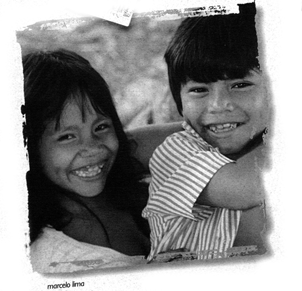Tikuna
kids /
Crianças
Tikuna
Aldeia
Filadelfia
BenjaminConstant,
Amazonas, Brasil
photo
(c)
Marcelo Lima
About
us /
Sobre
a Revista
Apoio
/ sponsors / partners
Presentation
/
Apresentação
Editorial
policy /
Normas
editoriais
Book
Reviews /
Resenhas
Review
Essays /
Ensaios
bibliográficos
Notas
de Leitura
Reading
Notes
Books
received /
Livros
recebidos
Web
Reviews / Links
general
index
table
of contents
indice
geral
Sign
our /
Assine
o nosso
Guest
Book /
Livro
de Visitas
Leia
o nosso /
Read
our
Livro
de Visitas /
Guest
Book
READER'S
FORUM
ESPAÇO
DO LEITOR
|
|
Book Reviews
/ Resenhas
Junho
/ June / 2002
Woodfield, Richard, editor
Art History as Cultural History:
Warburg's Project
Amsterdam: G+B Arts, 2001
293 p.
a review by Marcelo Guimarães
Lima
Recent translations of works
by Aby Warburg are allowing English-language readers interested
in the history of modern art history, a more direct examination
of a quasi-legendary figure, researcher and writer who appeared,
through the works of some of his associates and "pupils" in the post-war
US and in Europe, as a sort of grey-eminence" of art historical
studies. Art historians such as Panofsky, Saxl and Ernst Gombrich,
to name just a few, have acknowledged
the importance of Warburg in the
modern developments of the discipline,
specially in regard to the studies
of Renaissance art and culture, of
central importance for the early
methodological foundation of the
history of art in the last part
of the 19th and the early part of the
20th Century. And yet, the same
writers have revealed, in different,
more or less subtle ways, what we
may call a deep ambivalence towards
Warburg's art historical theory
and practice.
The present volume, edited by Richard
Woodfield, brings together
critical essays and the text of
a 1914 lecture on the art of the
Renaissance by Aby Warburg's himself
, as well two pieces by Ernst
Gombrich: an essay on the 19th century
notion of a "pagan revival"
(central to Warburg's investigations
on the Renaissance) and his
Warburg Centennial Lecture delivered
at the Warburg Institute of the
University of London in 1966.
In the introduction, series editor
Saul Ostrow observes that what we my
call the crisis of the dominant
positivistic model of art history of
the mid 20th Century, and the development
of Cultural Studies and Visual
Studies as interdisciplinary fields
in the later part of the century,
has prompted a renewal of interest
in Warburg's "attempt at producing a
cultural psychology". While recognizing
the heterogeneous nature of the
discipline of art history, Ostrow
nonetheless states that Warburg's
project had less to do with art
history per se than with the psychology
of culture, as embodied and processed
through works of art. One wonders
here if the setting of strict boundaries
between cultural practices and
cultural disciplines is not positivism
itself and, therefore, perhaps not the
best way of characterizing Warburg's
"antiformalist" and "antipositivist"
art history.
One of the main interests of Warburg's
unfinished work (a work that was
perhaps, by its very nature and
scope, impossible to complete) is the,
explicit or implicit, methodological
questioning of the foundations of the
discipline through the engagement
with the products of art considered as
living by and through their historical
contexts, in the confluence of a
horizontal (temporal) and
a vertical (psychological structural) series,
as both the mediators of culture
in time, that is, historical semiotic
entities: historical signs remaking
themselves across cultural epochs,
and the mediators of the structural
instances of the psychological
foundations of the human mind and
the human heart.
In this, Warburg's project echoes,
at times anticipates, or reproduces
in its own mode, some important
themes and ideas that, in different
ways, marked the theoretical passage
between the 19th and the 20th
Centuries, the soil of cultural
and theoretical developments such as
psychoanalysis, the study of symbolism
and logical analysis, structural
linguistics and semiotics, of existentialism
and the philosophy of
values (Nietzsche). The "symptomatic"
dimension of Warburg's works in
relation to its cultural soil may
in fact give us the key for the
"universal" difficulties of a more
coherent account of his "project":
Warburg's art historical project,
a work "between two worlds" we may
say, inhabits a sort of deserted
landscape at the foundations of
modernity (that very historical
modernity that was, in a general way,
one of its main objects) and confront
us still today, in its "untimely"
(Nietzsche) dimension, with the
dilemmas of historical possibilities.
One here may evoke Walter Benjamin's
researches on the passages
between historical epochs such as
the Baroque, the 19th and the 20th Centuries.
Benjamin's notion of the ruin (the
baroque ruin mirroed and transformed in the
romantic allegories of Baudelaire)
both as the image of the historical past,
of what once fully was,that is,
a given totality, as well as of arrested life,
of incompleteness and lack, explored
the dilemmas of historical time and experience. The paradox of the dialectical
fragment was Benjamin's central object, and the fragmentation of reified
totalities formed the core his methodological
praxis that aimed at the subversive
use of fragments.
Warburg's investigations of the migrations
and transformations of images across
times and cultures traced also the
fragments of cultural totalities and their
structural and functional mutations.
We can say that the fragmentation of art history itself as a historical
project and as cultural practice in our post-moderm time may prompt us
to a rereading of Warburg's that will perhaps contribute to produce a new
understanding of the dimensions of modernity and of our own moment.
copyright
(c) 2002 Centro de Estudos e Pesquisas Armando de Oliveira
Souza CEPAOS
return
to CEPAOS Review Homepage
endereço
mailing
address:
Caixa
Postal 12833
São
Paulo, 04009-970,
Brasil
fax:
303-200-8866
USA
www.cepaos.cjb.net
www.cepaosreview.cjb.net |

